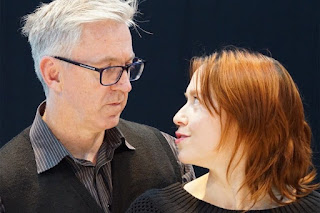Dead Man’s Cell Phone by Sarah Ruhl.
Directed by Kate
Blackhurst. Original music and production Glenn Gore Phillips. Choreography
Brooke Thomas. Set design. Cate Clelland. Lighting design Stephen Still. Sound
design. Neville Pye. Stage managers David Goodbody and Ann-Maree Padarin.
Production manager Liz de Toth. Canberra Repertory Society. June 13-29.
Bookings ^258 1950. www.canberrarep.org.au
Reviewed by Peter Wilkins
If Implausibility excites your
curiosity and your imagination, then you are likely to find Canberra Rep’s
production of Sarah Ruhl’s Dead Man’s
Cell Phone intriguing and curiously entertaining. You may need to willingly
suspend your disbelief to accept that a woman would take the cell phone from a
man she discovers to be dead in a café. Even curiouser is the fact that she
answers the calls and gradually becomes obsessed with the dead man’s phone, so
much so that she refuses to give it up to the family members whom she meets,
claiming that it was a gift from Gordon (Bruce Hardie in a very impressive Rep
debut).
 |
| Jess Waterhouse plays Jean in Dead Man's Cell Phone |
Ruhl’s unlikely chain of events begins with Jean (Jess Waterhouse) hearing the incessant ringing of Gordon’s phone. Her curiosity, and one suspects her solitary loneliness takes her on a journey to meet the people who ring. She meets the mother Harriet Gottlieb (Elain Noon) at the funeral, the mysterious Slavic mistress (Alex McPherson), the wife Hermia (Victoria Tyrell Dixon) and the man’s brother Dwight (Bruce Hardie), named because Mrs. Gottlieb ( which ironically means God’s love in English) felt sorry for the name. Jean’s desperate need to connect and reach beyond the impersonal distancing of digital technology leads her down a murky path of dark secrets.
Cate Clelland’s sculpturally
stylish design lends the production a contemporary perspective with rear
projection to suggest location. Simple changes of blocks to represent a
different venue and seating arrangement might have been more effective if the
stagehands had been in costume, e.g. waiters’ outfits. Neville Pye’s sound
design created a suitable ambience to the scenes, subtly complemented by
Stephen Still’s lighting design.
 |
| Bruce Hardie as Dwight and Jess Waterhouse as Jean |
Director Kate Blackhurst has assembled an excellent cast, each actor creating a thoroughly plausible performance in this largely implausible work. Waterhouse is the epitome of the innocent caught in circumstance beyond her understanding. She exudes goodness and good intention and there is a delightful girlish naivety to her performance, captured charmingly in the attraction between her and Hardie’s caring and good natured Dwight. Noon’s fearsome and crotchety mother still manages to expose the mother’s grief and Dixon’s Hermia exudes the bitter coldness of the cheated and neglected wife. McPherson gives a finely drawn performance of the experienced and somewhat intimidating “other woman”
Playwright Ruhl obviously has an
opinion on the prevalence and potential dangers of cell phones. At its core,
the play is about human connectedness and the effect technology has on that
connectedness. In an opening monologue to Act Two, the dead Gordon attempts to
justify his unethical occupation when alive by emphasising his connection with
those in need. Is Jean’s compulsive possession of Gordon’s cell phone sufficient justification for her obsessive desire
to twist the truth to restore positive human
connection through the dead man’s cell phone? It is for you the audience to judge
as you may feel compelled to habitually reach for your mobile phone during the
interval at Canberra Rep’s enjoyable production of Dead Man’s Cell Phone.
